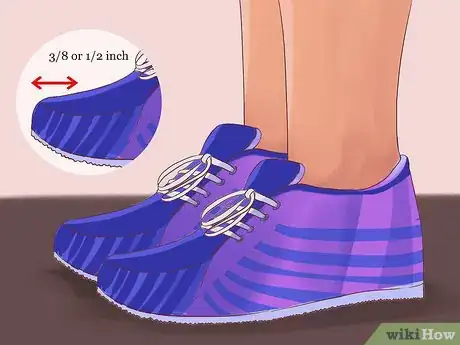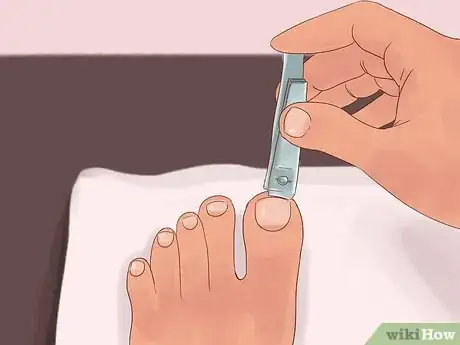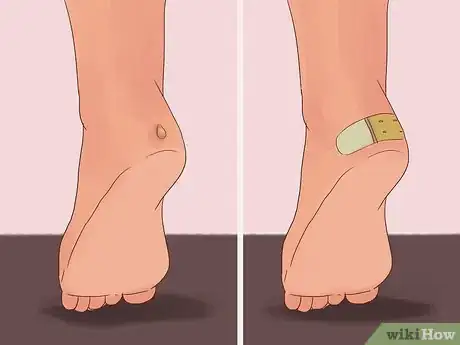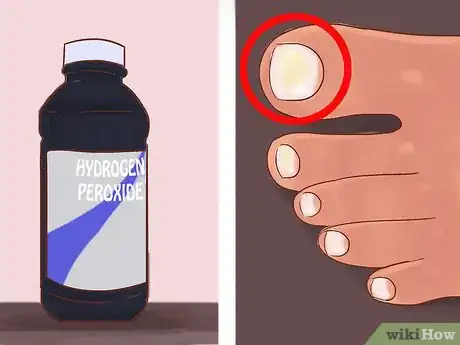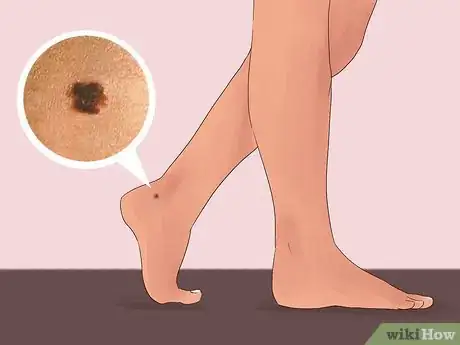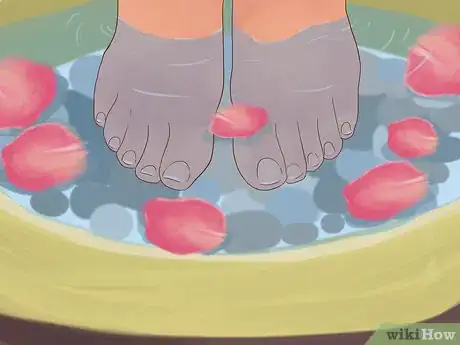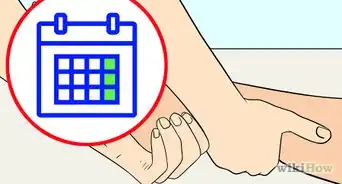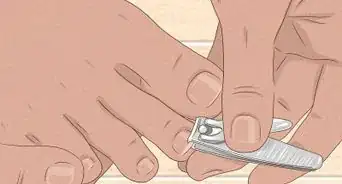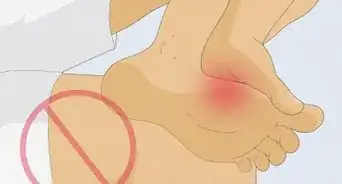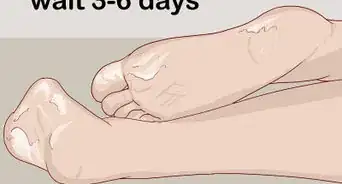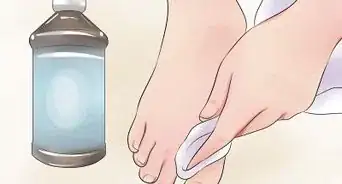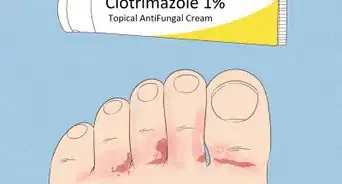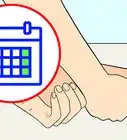This article was co-authored by Miguel Cunha, DPM. Dr. Miguel Cunha is the founder of Gotham Footcare and is a podiatrist based in Manhattan, New York. Dr. Cunha is a foot and ankle surgeon with experience treating a wide array of foot and ankle conditions from minor problems to complex reconstructive foot and ankle surgery. Dr. Cunha received his DPM from the Temple University School of Podiatric Medicine and completed his residency as the Chief Resident at the Washington Hospital Center and Georgetown University where he specialized in lower extremity trauma, diabetic limb salvage, and reconstructive surgery of the foot and ankle. Dr. Cunha is a member of the American Podiatric Medical Association, the New York Podiatric Medical Association, the American College of Foot and Ankle Surgeons, and is board certified in Podiatric Medicine.
There are 10 references cited in this article, which can be found at the bottom of the page.
wikiHow marks an article as reader-approved once it receives enough positive feedback. In this case, 80% of readers who voted found the article helpful, earning it our reader-approved status.
This article has been viewed 311,783 times.
Many people are insecure about the appearance of their feet. As feet are exposed to a lot of day-to-day damage, calluses, rough skin, and other troublesome issues are common. However, your feet are responsible for moving you around, supporting your body weight, and maintaining your posture, so be sure to take a little time to care for them each day!
Steps
Caring for Your Feet
-
1Do foot soaks regularly. Some basic foot care can help your feet look smooth and soft. Doing regular foot soaks can help remove dead skin cells and moisturize your feet.
- A foot soak should last around 10 minutes. Any longer could leave your feet dry and cracked. Aim for lukewarm water. Water that's too hot or too cold could cause redness and other damage.[1]
- You can soak your feet in plain water. If you have sensitive skin that tends to react poorly to additives, this might be your best bet. However, adding certain ingredients can help make the foot soak more relaxing and help moisturize and clean your feet.[2]
- Listerine is a type of mouth wash that some doctors recommend for foot soaks. Mix one part Listerine with two parts warm water. Soak your feet for 15 to 20 minutes and then apply a moisturizer.[3]
-
2Exfoliate. Exfoliating feet is important to have strong, healthy feet. Exfoliation is a process by which dead skin cells are removed. You should exfoliate your feet once a week to keep them looking smooth and soft.
- There are many ways to exfoliate your feet. You can buy foot creams and gels at department stores that come with micro-beads or other exfoliating agents. Use such creams as directed on the box. However, keep in mind that micro-beads have a somewhat bad reputation amongst environmentalists. Beads are not biodegradable and end up causing pollution.[4]
- Many people get good results by making their exfoliating cream at home. Any grainy substance, such as sea salt or Epsom salt, can be mixed with water or soap and rubbed against the feet.[5]
- To exfoliate, you rub your cream of choice into your feet. Use enough force to smooth out rough patches and remove dead skin cells. Then, rinse your feet and moisturize.
Advertisement -
3Select proper footwear. A major factor in caring for your feet is selecting the right shoes. Shoes that are too tight can cause calluses, pain, and other damage.
- Go to a shoe store and have your feet measured before selecting shoes. A salesperson can assist you in determining what size shoe would work best for you.[6]
- Keep in mind most people have one foot that is slightly larger than the other. Select shoe size based on the larger of your two feet. It's better to have shoes that are slightly too loose than shoes that are slightly too tight.[7]
- When standing, there should be about 3/8" or 1/2" inch, about the width of a finger, between your longest toe and the end of the shoe.[8]
- Walk around in shoes for a while before making a purchasing decision. Make sure shoes don't chafe or rub in any uncomfortable places.[9]
- Taking these precautions with your shoes is the main way to prevent issues like corns, calluses[10] , and bunions.[11]
-
4Moisturize. Feet encounter a lot of wear and tear on an average day. A lot of oils and moisture are lost through day-to-day walking. Use a moisturizer for your feet regularly. You can use your normal moisturizer or lotion. However, a stronger moisturizer might be required for feet. You can find moisturizers specifically designed for use on feet at a local supermarket or beauty store.[12]
- Do not use moisturizer between your toes, as it may not dry properly and could lead to a fungal infection.[13]
-
5Clip your toenails properly. Damages like ingrown toenails can result from improper toenail trimming. Always clip your toenails straight across and then use an emery board to file them to your desired shape. Many people try to build a round toenail shape by clipping the toenails in a certain way but this can cause toenails to bend inward. This can result in ingrown toenails.[14]
Fixing Damage
-
1Smooth out calluses and rough skin. Calluses and rough patches of skin are common on feet. There are several ways to address this problem.
- If you have painful calluses or corns, apply urea to your feet and wrap them in plastic wrap, then put on socks. Let the cream sit overnight, and in the morning, use a pumice stone to remove the thickened skin.[15]
- An electronic callus remover is a handheld motorized device that is used to remove smooth out rough skin and remove calluses from the skin. It requires less effort than other means. However, callus removers can be somewhat pricey, costing between $20 and $30.[16]
- If you do not want to spend extra money, a foot file or pumice stone might be a good option. You can use a metal or diamond file to rub out calluses and rough skin. You can similarly use a pumice stone, but some find it to be less effective than other means.[17]
-
2Allow blisters to heal. In the event of blisters, your best option is to allow them to heal on their own. Trying to cure blisters via removal can cause scarring and, in rare cases, infection.
- Keep the blister clean and protected throughout the day. Gently wash the blister in the morning with a mild, antibacterial soap. Then apply a band-aid to the blistered area.[18]
- Blisters need to breathe to heal, so when possible take your shoes and socks off and remove any bandages. You may have to wait until you're home from work or school to do so.[19]
-
3Remove stains from toenails. Toenails sometimes get stained with dirt and debris. It's fairly easy to remove a toenail stain using household items.
- Toothpaste, whitening strips, and hydrogen peroxide are all effective means of un-staining toenails. Hydrogen peroxide is the best option. Stain a q-tip or cotton ball with hydrogen peroxide and gently dab on the stained area. Wait for 3 to 5 minutes before washing the peroxide off.[20]
- If you do not have hydrogen peroxide, you can try the same process using whitening strips or toothpaste. Keep in mind this may be less effective.[21]
Seeking Professional Care
-
1Have unusual marks evaluated by a dermatologist. If you notice unusual marks on your feet and under your toenails that do not go away with at-home treatments, see a dermatologist. In rare cases, such marks can be a sign of a skin cancer known as melanoma.
- Melanoma usually occurs in areas of the body heavily exposed to the sun. However, it has been known to appeal under toenails and on the soles of feet. Check these areas on the regular basis for any new moles or unusual changes to the skin.[22]
- Melanoma usually starts as a normal mole and then changes and becomes cancerous. Asymmetrical moles, have irregular or scalloped borders, change in colour over time, are larger than 1⁄4 inch (0.6 cm) in diameter, or evolve in colour, shape, and size may be a sign of melanoma. If you notice any such moles on your feet, make an appointment with a dermatologist for evaluation.[23]
-
2Get pedicures regularly. As stated, feet are exposed to a lot of damage throughout the day. Make regular appointments with a pedicurist for deeper exfoliation and skin renewal treatments. Regular pedicures can help you maintain healthy, attractive feet.
- Be sure to check your feet at home regularly, as well. If you notice pain or swelling or swelling in the colour, texture, or hydration of your skin or nails, see a podiatrist.[24]
-
3See a doctor in the event of foot fungus. Toenail fungus is marked by brittle, thick, misshapen, and yellowish toenails. If you believe you have foot fungus, see a doctor for evaluation and treatment.[25]
- You can help prevent bacteria and foot fungus by spraying a disinfectant spray into your feet each day.[26]
- Your doctor will likely prescribe a round of oral antifungal drugs to treat nail fungus. You usually take these drugs from 6 to 12 weeks. Take any medication your doctor prescribes as directed. Ask your doctor or pharmacist for guidance if you have any questions about the medication. Medicated nail polish or nail cream may be prescribed alongside medication depending on the severity of the fungus.[27]
- In rare cases, your doctor may want to surgically remove a nail if the fungus is severe. A new nail will grow in its place, but it may take a long time. You might have to wear protective bandages around your foot as the new nail grows.[28]
Expert Q&A
-
QuestionWhat is the best homemade foot soak?
 Miguel Cunha, DPMDr. Miguel Cunha is the founder of Gotham Footcare and is a podiatrist based in Manhattan, New York. Dr. Cunha is a foot and ankle surgeon with experience treating a wide array of foot and ankle conditions from minor problems to complex reconstructive foot and ankle surgery. Dr. Cunha received his DPM from the Temple University School of Podiatric Medicine and completed his residency as the Chief Resident at the Washington Hospital Center and Georgetown University where he specialized in lower extremity trauma, diabetic limb salvage, and reconstructive surgery of the foot and ankle. Dr. Cunha is a member of the American Podiatric Medical Association, the New York Podiatric Medical Association, the American College of Foot and Ankle Surgeons, and is board certified in Podiatric Medicine.
Miguel Cunha, DPMDr. Miguel Cunha is the founder of Gotham Footcare and is a podiatrist based in Manhattan, New York. Dr. Cunha is a foot and ankle surgeon with experience treating a wide array of foot and ankle conditions from minor problems to complex reconstructive foot and ankle surgery. Dr. Cunha received his DPM from the Temple University School of Podiatric Medicine and completed his residency as the Chief Resident at the Washington Hospital Center and Georgetown University where he specialized in lower extremity trauma, diabetic limb salvage, and reconstructive surgery of the foot and ankle. Dr. Cunha is a member of the American Podiatric Medical Association, the New York Podiatric Medical Association, the American College of Foot and Ankle Surgeons, and is board certified in Podiatric Medicine.
Board Certified Podiatrist Try soaking your feet in lukewarm water mixed with Epsom salt and 2 tablespoons of apple cider vinegar to soften up any calluses on your feet.
Try soaking your feet in lukewarm water mixed with Epsom salt and 2 tablespoons of apple cider vinegar to soften up any calluses on your feet. -
QuestionHow should I take care of my feet every day?
 Miguel Cunha, DPMDr. Miguel Cunha is the founder of Gotham Footcare and is a podiatrist based in Manhattan, New York. Dr. Cunha is a foot and ankle surgeon with experience treating a wide array of foot and ankle conditions from minor problems to complex reconstructive foot and ankle surgery. Dr. Cunha received his DPM from the Temple University School of Podiatric Medicine and completed his residency as the Chief Resident at the Washington Hospital Center and Georgetown University where he specialized in lower extremity trauma, diabetic limb salvage, and reconstructive surgery of the foot and ankle. Dr. Cunha is a member of the American Podiatric Medical Association, the New York Podiatric Medical Association, the American College of Foot and Ankle Surgeons, and is board certified in Podiatric Medicine.
Miguel Cunha, DPMDr. Miguel Cunha is the founder of Gotham Footcare and is a podiatrist based in Manhattan, New York. Dr. Cunha is a foot and ankle surgeon with experience treating a wide array of foot and ankle conditions from minor problems to complex reconstructive foot and ankle surgery. Dr. Cunha received his DPM from the Temple University School of Podiatric Medicine and completed his residency as the Chief Resident at the Washington Hospital Center and Georgetown University where he specialized in lower extremity trauma, diabetic limb salvage, and reconstructive surgery of the foot and ankle. Dr. Cunha is a member of the American Podiatric Medical Association, the New York Podiatric Medical Association, the American College of Foot and Ankle Surgeons, and is board certified in Podiatric Medicine.
Board Certified Podiatrist Check your feet regularly for any signs of pain, swelling, or unusual changes. Keep your feet moisturized by using a thin coat of lotion over them, but avoid putting lotion between your toes, as it could lead to a fungal infection. Also, cut your toenails straight across, then use an emery board to smooth out the corners.
Check your feet regularly for any signs of pain, swelling, or unusual changes. Keep your feet moisturized by using a thin coat of lotion over them, but avoid putting lotion between your toes, as it could lead to a fungal infection. Also, cut your toenails straight across, then use an emery board to smooth out the corners.
Warnings
- If you have diabetes, see a podiatrist for a foot evaluation every 3 months.[29]⧼thumbs_response⧽
References
- ↑ http://www.crunchybetty.com/extreme-toe-makeover-easy-remedies-for-pretty-feet
- ↑ http://www.crunchybetty.com/extreme-toe-makeover-easy-remedies-for-pretty-feet
- ↑ http://www.webmd.com/beauty/nails/expert-answers-to-your-foot-care-questions
- ↑ http://www.crunchybetty.com/extreme-toe-makeover-easy-remedies-for-pretty-feet
- ↑ http://www.crunchybetty.com/extreme-toe-makeover-easy-remedies-for-pretty-feet
- ↑ https://www.aofas.org/footcaremd/how-to/footwear/Pages/10-Points-of-Proper-Shoefit.aspx
- ↑ https://www.aofas.org/footcaremd/how-to/footwear/Pages/10-Points-of-Proper-Shoefit.aspx
- ↑ https://www.aofas.org/footcaremd/how-to/footwear/Pages/10-Points-of-Proper-Shoefit.aspx
- ↑ https://www.aofas.org/footcaremd/how-to/footwear/Pages/10-Points-of-Proper-Shoefit.aspx
- ↑ https://www.mayoclinic.org/diseases-conditions/corns-and-calluses/symptoms-causes/syc-20355946
- ↑ https://www.mayoclinic.org/diseases-conditions/bunions/symptoms-causes/syc-20354799
- ↑ http://www.elle.com/beauty/makeup-skin-care/tips/a28092/how-to-get-great-feet-at-home/
- ↑ Miguel Cunha, DPM. Board Certified Podiatrist. Expert Interview. 22 April 2020.
- ↑ http://www.prevention.com/beauty/natural-beauty/natural-tips-for-pretty-feet/step-2-shape
- ↑ Miguel Cunha, DPM. Board Certified Podiatrist. Expert Interview. 22 April 2020.
- ↑ http://www.elle.com/beauty/makeup-skin-care/tips/a28092/how-to-get-great-feet-at-home/
- ↑ http://www.elle.com/beauty/makeup-skin-care/tips/a28092/how-to-get-great-feet-at-home/
- ↑ http://www.elle.com/beauty/makeup-skin-care/tips/a28092/how-to-get-great-feet-at-home/
- ↑ http://www.elle.com/beauty/makeup-skin-care/tips/a28092/how-to-get-great-feet-at-home/
- ↑ http://www.elle.com/beauty/makeup-skin-care/tips/a28092/how-to-get-great-feet-at-home/
- ↑ http://www.elle.com/beauty/makeup-skin-care/tips/a28092/how-to-get-great-feet-at-home/
- ↑ http://www.mayoclinic.org/diseases-conditions/melanoma/basics/symptoms/con-20026009
- ↑ http://www.mayoclinic.org/diseases-conditions/melanoma/basics/symptoms/con-20026009
- ↑ Miguel Cunha, DPM. Board Certified Podiatrist. Expert Interview. 22 April 2020.
- ↑ https://www.mayoclinic.org/diseases-conditions/nail-fungus/symptoms-causes/syc-20353294
- ↑ Miguel Cunha, DPM. Board Certified Podiatrist. Expert Interview. 22 April 2020.
- ↑ https://www.mayoclinic.org/diseases-conditions/nail-fungus/symptoms-causes/syc-20353294
- ↑ https://www.mayoclinic.org/diseases-conditions/nail-fungus/symptoms-causes/syc-20353294
- ↑ Miguel Cunha, DPM. Board Certified Podiatrist. Expert Interview. 22 April 2020.
About This Article
If you want your feet to look smooth and attractive, practice some basic care and maintenance. To keep your feet silky soft, soak them in lukewarm water and sea salt, Epsom salt, oatmeal, or essential oils for 10 minutes at a time, several times a week. Once a week, exfoliate your feet with an exfoliating cream or gel to remove any dead skin cells. Also, get into the habit of moisturizing your feet on a daily basis to protect them against dry or cracking skin. Another major factor in caring for your feet is picking the right shoes since ones that are too tight can lead to calluses, pain, and other damage. When you stand, make sure you have about ½ inch between the end of your longest toe and the end of your shoe. To learn how to remove stains from toenails, keep reading!

